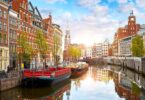Admiring art in a typical museum, while enjoyable and often edifying, lacks a certain personality. You might see the names of the donors on the label beside the artwork on the museum wall, but you often don’t get a real sense of who those people are and how this work fits into a larger aesthetic and, indeed, their lives.
Fortunately, there are many museums that are housed within the former residences of affluent individuals or curated from their private collections. These museums offer a distinctive lens through which to perceive art, providing an intimate connection between the art and the domestic settings that once encompassed them. Walking through these opulent spaces, now transformed into galleries, visitors gain a deeper appreciation for the art’s historical context, the tastes of its original owners, and the eras in which they lived.
The Isabella Stewart Gardener Museum — Boston

Isabella Stewart Gardner Museum 2016 by Putneypics licensed under CC BY-ND 2.0
The Isabella Stewart Gardner Museum in Boston is a unique treasure trove of art, established by the remarkable Isabella Stewart Gardner in the late 19th century. A vivacious and unconventional woman, Mrs. Gardner possessed an insatiable passion for collecting art from around the world. She meticulously designed her residence to resemble a Venetian palace, harmoniously blending architecture and art.
Unfortunately, the museum is also famous for a notorious theft. In 1990, two thieves disguised as police officers stole 13 priceless artworks, including pieces by Vermeer, Rembrandt, and Degas, in a brazen heist. To this day, the stolen works remain missing, leaving empty frames as a haunting reminder of the audacious robbery. However, this incident only heightens the mystique of the museum, reinforcing its status as a repository of both artistic beauty and intriguing history.
The Phillips Collection — Washington, D.C.

The Phillips Collection, Washington, DC (Photo taken by author)
The Phillips Collection, located in the Dupont Circle area of Washington, D.C., is known for its impressive collection of modern and contemporary art. It was founded by Duncan Phillips and opened to the public in 1921. The museum was actually America’s first museum of modern art, preceding the Museum of Modern Art (MoMA) in New York City by about eight years.
Duncan Phillips, along with his mother Eliza, started collecting art in the late 19th century. The Phillips Collection grew out of their private holdings, which primarily focused on European and American artists of the late 19th and early 20th centuries. Duncan Phillips was a particularly strong advocate for modern art, and he aimed to create a space in which the works of contemporary artists could be showcased alongside older pieces, fostering a dialogue between different artistic periods.
The Frick Collection – New York City

Frick Dining Room by Paul Gorbould licensed under CC BY-ND 2.0
The Frick Collection is simply astounding. Located on 5th Avenue on the Upper East Side of in New York City, the Frick is a testament to the refined tastes and discerning eye of its founder, Henry Clay Frick. Frick was a prominent industrialist and art collector in the late 19th and early 20th centuries, and his opulent mansion now houses his impressive collection.* The museum offers an intimate encounter with masterpieces by such renowned artists as Vermeer, Rembrandt, Titian, El Greco, and Holbein.
What sets the Frick Collection apart is its juxtaposition of grandeur and intimacy. The artworks are displayed in the sumptuous setting of Frick’s former residence, allowing visitors to experience art in an environment redolent with history. The seamless fusion of art, architecture, and decorative arts creates a harmonious atmosphere that transports visitors to another era. This combination of exquisite art and an elegant domestic backdrop offers an immersive encounter with some of the finest examples of human expression.
*As of this writing, the mansion is under renovation, and the collection is on view at old Whitney Museum building on Madison Avenue. The mansion is set to reopen in late 2024.
The Norton Museum of Art — West Palm Beach

Norton Museum of Art Front Façade by Nortonedits licensed under CC BY-ND 2.0
The Norton Museum of Art, located in West Palm Beach, Florida, is known for its impressive collection of artworks spanning various periods and styles, including European, American, Chinese, contemporary, and decorative arts. The museum’s European collection includes works by Monet, Gaugin, Chagall, Matisse, and Picasso.
The Norton Museum was founded by Ralph Hubbard Norton and his wife Elizabeth Calhoun Norton. Ralph Norton was a successful industrialist and businessman, primarily involved in the American coal industry. The collection was initially displayed in the Nortons’ home, but as their collection expanded and their desire to make the art accessible to a wider audience grew, the Nortons decided to establish a dedicated institution for their collection. In 1941, they opened the Norton Gallery and School of Art in a building designed to house their art collection and offer art education to the local community.
The Huntington — San Marino, CA

Huntington Library Art Collections and Botanical Gardens by Smart Destinations licensed under CC BY-ND 2.0
The full name of this delightful institution is the Huntington Library, Art Museum, and Botanical Gardens, although it’s most commonly referred to as simply “The Huntington.” The collection is located in San Marino, California, just outside of Los Angeles. The museum was established based on the extensive collection of Henry E. Huntington, an American businessman, philanthropist, and collector. Huntington’s collection became the foundation for the institution, which officially opened to the public in 1928.
Notable works at The Huntington include a vast array of rare books and manuscripts, including a Gutenberg Bible, original manuscripts of literary classics, and historical documents. The art collection encompasses European and American paintings, decorative arts, and sculptures from the 17th to 19th centuries. Thomas Gainsborough’s celebrated portrait The Blue Boy is among the highlights of the collection. In addition, The Huntington’s botanical gardens are renowned for their diverse and extensive plant collections, including themed gardens like the Desert Garden, Japanese Garden, and Rose Garden.
You Might Also Enjoy: 9 Fabulous Art Museums Around the World You’ll Definitely Want to Visit
The Barnes Foundation — Philadelphia

Barnes Gallery Interior by Drozdp licensed under CC BY-ND 2.0
This one is a bit controversial, but we’ll get to that in a second. The Barnes Foundation, situated in Philadelphia, is celebrated for its remarkable assortment of Impressionist, Post-Impressionist, and early Modernist artworks. The foundation was established by Dr. Albert C. Barnes in 1922, and stands out due to its distinctive presentation method.
Dr. Barnes was very particular about his collection, and laid out the various rooms of his house in a meticulous manner. He juxtaposed his many distinctive artworks with “ordinary objects” like wrought-iron hinges, door handles, and African sculptures. Barnes hoped that these juxtapositions would encourage viewers to make connections between seemingly unrelated forms, thereby fostering a deeper appreciation for both art and everyday artifacts.
Now for the controversy. The Barnes Collection used to be housed at the Barnes Mansion in suburban Merion. However, in 2012, the collection was relocated to a new downtown Philadelphia facility, sparking an intense debate about Barnes’ wishes that the collection remain exactly where it was. But the mansion was in a part of Philadelphia that was hard for visitors to get to, and parking was extremely limited. The foundation trustees eventually decided to break with Dr. Barnes instructions and relocate the collection to a new state-of-the-art facility near downtown Philly. In the process, they hoped to make these masterpieces more accessible to the public, and broaden the mission of the museum for the benefit of all.
Did we leave off your favorite private collection turned public museum? Tell us about it in the comments below!
Featured Image: Garden Court, The Frick Collection, New York, NY by Frank Fujimoto licensed under CC BY-ND 2.0









You are missing The Frederick R. Weisman Art Foundation. A non-profit arts foundation located on North Carolwood Drive in the Holmby Hills district of Los Angeles, California.
Address: 265 N Carolwood Dr, Los Angeles, CA 90077